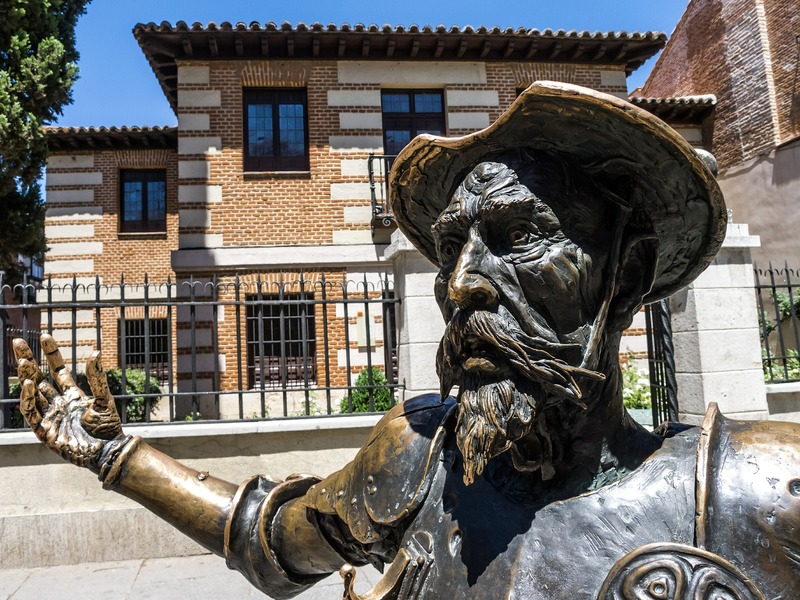Our recommended reading list
02/09/2020Reading, or making his mind travel.
With great classics and less famous works, SpainTOP invites you to discover a selection of books that evoke our destinations. This is an opportunity to travel ahead of time or prolong the experience, but also to place your trip in a historical, social and cultural dimension… and slide your steps into those of authors and imaginary characters who have traveled across Spain, Portugal or Morocco before you.
Autobiographical dimension or adventures of fictional characters, journeys lived or dreamed: the escape is assured. This is the time for you to dive into the medieval Spain of Cervantes, discover the romantic Seville of the 19th century or share the emotions of George Sand in front of the Majorcan landscapes.
Here is our selection of books to read before, during or after your trip:
ABOUT SPAIN :
- Miguel de Cervantes: Don Quixote, 1605
«The Ingenious Gentleman Don Quixote of La Mancha» is the absolutely mythical work of Spanish and universal literature. A bestseller since its inception, Cervantes' masterpiece is considered the first modern novel and has influenced countless authors, some of them seeing here the best literary work ever written. It is about the adventures of the noble hidalgo Don Quixote de la Mancha and his squire, Sancho Panza.
- Federico García Lorca: Blood Wedding, 1931
This is one of Garcia Lorca’s most important works. This drama is inspired by the traditional life of the Andalusian villages, to retrace the tragic history of an impossible passion. Since its premiere on March 8, 1933 at Beatriz Theatre in Madrid, this verse tragedy has been the subject of numerous interpretations, including cinema, opera and flamenco shows.
- Ernet Hemingway: Death in the Afternoon, 1932
In this mythical book, the sacred monster of American literature passionate about Spain takes us from Paris to Madrid. Above all, he tells us about the San Fermin fair in Pamplona, which he participated in making so famous internationally. For an explanation of the bullfighting rites from A to Z, we will follow the enthusiastic details of the author in his autobiographical books Death in the Afternoon, 1932 and The Dangerous Summer, 1960.
- Cees Nooteboom: Roads to Santiago, 1992
On the way to Santiago de Compostela, the traveler passes through Aragon, Soria and Granada, also through the island of La Gomera and the Padro Museum. A magnificent travel story to Spain, from this Dutch author in love and really connoisseur of the country.
- How not to mention here the numerous works from the 19th Century. Like painters and other artists, the authors became infatuated at this time for the exotic and romantic Spain, and Andalusia in particular. We think in particular in Travels in Spain, by North American George Ticknor (1818); of the numerous writings of his compatriot Washington Irving a few years later; of the Trip to Spain by the French poet, dramatist, novelist and journalist Théophile Gautier (1843) ; to A Handbook for Travellers in Spain by Richard Ford of Great Britain (1844); to Carmen, the short story by Prosper Mérimée (1845) which inspired the mythical opera by George Bizet, the most performed in the world.
ABOUT PORTUGAL :
- Jose Saramago: Blindness, 1995
*** This is our special nod to the current situation *** This novel by the Portuguese writer and Nobel Prize winner imagines the consequences of a devastating epidemic of blindness on the whole population of a country. - Jose Saramago: Raised from the Ground, 1980The same author Jose Saramago takes us to the Alentejo. From the beginning of the 20th century to the Carnation Revolution in 1974, the book tells the story of a family of agricultural workers in this arid region over three generations.
- Antonio Tabucchi: Pereira Maintains,1994
The setting of the novel is Salazar’s Portugal at the dawn of the Second World War. We follow the story of a Portuguese journalist who works for a newspaper in the capital. The book received the prestigious Campiello and Viareggio awards in the country of its author, Italy.
- António Lobo Antunes: Archipelago of Insomnia, 2008
This profound and poetic book tells about the emergence and decline, in the 20th Century, of a great domain beyond the Tagus. Its author is one of the essential figures of contemporary Portuguese literature.
ABOUT MOROCCO :
- Paul Bowles: The Sheltering Sky, 1949
Paul Bowles, composer, writer, and American traveler, spent most of his life in Morocco. The novel is on the list of the 100 best English-language novels of the 20th century. It is about a couple from New York travelling to the North African desert, accompanied by a friend. Their expectation of an adventure in the Sahara as a source of oxygen for a couple in crisis, will be put to a hard test.
- Tahar Ben Jelloun: The Sand Child, 1985 & The Sacred Night, 1987
The most translated French-speaking author in the world, the Moroccan Tahar Ben Jelloun became famous with The Sand Child. This novel based on a real fact tells the story of Ahmed, the eighth daughter of a couple who, without a male heir, decides to raise her as a boy. He followed it up in 1987, with another success that received the prestigious Prix Goncourt.
- Malika Oufkir: Stolen Lives: Twenty Years in a Desert Jail, 1999
The author is the daughter of General Mohamed Oufkir (executed after an attempted coup in 1972), adopted by King Mohammed V and imprisoned by Hassan II from 1972 until the 1990s. Here she tells the story of her life in prison, with French journalist Michèle Fitoussi.


 English
English Español
Español Français
Français Português
Português Русский
Русский